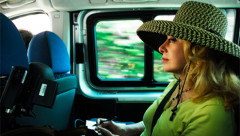In early 2011, I read The Jews of San Nicandro, a book written by a professor, John Davis. It’s about a group of Italian Roman Catholics in a small village who underwent a mass conversion to Judaism in fascist Italy, and who, over a period of 20 years of observing Jewish practices, left Italy and immigrated to the new state of Israel in 1949.
It’s a story that defies belief, an event that was, I believe, the only formal mass conversion to Judaism in modern history.
I was immensely fascinated by it. Being of Italian origin, I was even more curious, since the photos of San Nicandro reminded me of the village of my parents’ birth. I began to wonder how ordinary people could give themselves over to a new way of worshipping over many years, and what sustained them.

I was especially interested in what had become of the descendants of the San Nicandro population. Were they still in Israel?
When we found some of the original settlers in Israel, they didn’t want to speak to us. They didn’t want the attention. It was a mystery to us.
When we finally interviewed one of the descendants, he explained that the community had a very difficult time in Israel in those early years. Not only with the physical hardships but with the rabbis who did not accept them as Jews. One couple that wanted to get married had to take their case to the Supreme Court to force a rabbi to marry them. So they didn’t want to be interviewed for the film, since they didn’t want to bring attention to their Catholic origins.
I also wondered whether there were any converts left in San Nicandro itself. As fate would have it, when we met with the descendants, we found that there was a group undergoing a new conversion. I contacted the chief rabbi of Naples, who was supervising the new converts.
In the meantime, where was I going to get the funding to make the film? I couldn’t get the story out of my mind. As a producer, I tried to talk myself out of trying to find broadcast funding. Who would fund this in Canada? But I kept coming back to the story.
I also kept wondering about Donato Manduzio – a disabled cobbler from San Nicandro who had only learned to read as a solider in the First World War. Manduzio’s revelations, observances of Jewish practices in the Old Testament and his teachings of them over a period of 20 years would permanently change the lives of hundreds of people. His determination to bring back Old Testament Judaism spawned a whole generation of Italian Jews in Israel and Italy today.
We were determined to find them.
The biggest mystery, for me, is why Judaism is now undergoing a massive revival in Sicily and Calabria. Could it be because of the Internet?
As I continued my research, I discovered that the larger story was indeed happening today. There is a powerful revival of Judaism in Italy. We found Italy’s first female rabbi, Barbara Aiello, who recently opened the first synagogue in southern Italy in 500 years. And we discovered the new communities of Jewish presence in Calabria and Sicily, the areas with an ancient Jewish population before the Spanish Inquisition forced Jews to flee.
In my mind, The Mystery of San Nicandro is ultimately a testament to the inexorable force of the past, how it shapes our identity and sense of belonging, and how the echo of our DNA reaches across centuries to claim us. That echo is universal. No matter what our differences, we all have an ancestral journey and a past.
I then decided to construct the film as three interweaving stories: the original tale of the Jews of San Nicandro and their descendants in Israel, the modern conversion story in San Nicandro, and the larger significant story of the revival of Judaism in southern Italy –- a revival that is bringing Italian North Americans (whose families are from southern Italy and who suspect they are of Jewish ancestry) back to the towns of their forefathers to undergo bar mitzvahs and other religious ceremonies.
The Mystery of San Nicandro will appeal to anyone who has been curious about their ancestry. This is a universal and timeless story about the search for one’ s roots. During the making of the film, we met people who, though they had been raised as Catholics, knew or suspected that their origins were Jewish. Rabbi Barbara Aiello talks of people asking her for help because a relative, in a deathbed confession, revealed that the family was really Jewish.
On the surface, the film is the story of a messianic leader who was responsible for the only mass conversion to Judaism in modern history. But the modern stories are about the revival of Judaism in southern Italy, where traces of Judaism were wiped out after the Spanish Inquisition swept over Calabria and Sicily in the 1500s.
It’s also about the power that our past has over us -– how it shapes who we are, perhaps without us consciously knowing it, and lays claim to the deepest part of us. People have a powerful need to know who their ancestors were –- what faith, what culture they’re descended from.
In many cases, it’s especially shocking for people to find out that they’ve been practicing one faith all their lives but their origins turn out to reveal a different faith. What happens to those people?
As one of the rabbis in the film says, you may forget but your DNA doesn’t forget. To me, the film illustrates that power.
The Mystery of San Nicandro will be screened on Sunday, Nov. 3 at 4 p.m. at the Columbus Center (901 Lawrence Avenue West) as part of Holocaust Education Week in Toronto.